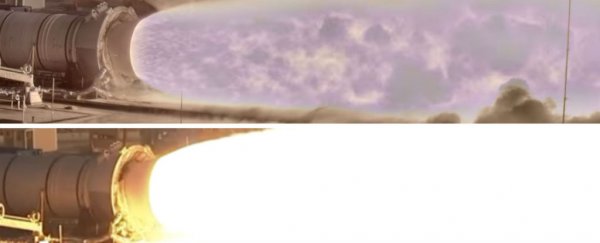You've probably never thought about it, but no matter how many rocket launches you've watched on YouTube or IRL, you've never seen what a rocket plume actually looks like.
Sure, you've can watch that massive stream of white light gushing from the rocket as it blasts towards space, but that's not even half as cool as what you can see behind all that glare, and no camera has been sophisticated enough to show it to you. But lucky for us, NASA's here to put things right.
NASA has been working on what it calls the High Dynamic Range Stereo X (HiDyRS-X) project - a revolutionary high-speed, high dynamic range camera that was completed just in time to film the recent full-scale test of the Space Launch System's (SLS) booster at Orbital ATK's test facility in the Utah desert.
Just to give you an idea of how freaking huge the SLS is, it's going to be employing TWO of these 17-storey-high solid rocket boosters when it blasts into space for its first test flight in late 2018.
Set to be the most powerful rocket ever built, the SLS will take NASA astronauts farther into deep space than ever before, with twin boosters burning 5 tonnes of propellant per second to create 3.6 million pounds (1.6 million kg) of thrust to kick-start the journey.
To make all this happen, NASA engineers have to know exactly how every part of the SLS is performing - something that can be especially difficult when you're trying to study a fiery booster plume that's brighter by several orders of magnitude than anything they've tested before.
"The problem when it comes to filming tests like these (and eventually, launches) is that the plumes of fire they produce are extremely bright," Sean O'Kane reports for The Verge.
"This usually leaves camera operators with two choices. They can either expose the footage for the bright plume, which will leave everything else in the shot looking dark and underexposed. Or they can expose for everything else in the shot, which leaves the plume looking bright white and void of detail."
Instead of recording one exposure at a time, NASA's HiDyRS-X camera is able to record multiple slow-motion exposures at once, and combine them into a "high dynamic range video" that reveals every part of the action being shot.
We could tell you the result is spectacular, mesmerising, hypnotic, and actually kinda scary, but you should just go ahead and watch it for yourself:
Incredibly, the booster launch was so powerful, it managed to accidentally shut down the power source for the HiDyRS-X - meaning the SLS engineers still have their work cut out to get this thing ready for the actual rocket launch in 2018.
"Once engaged, the camera recorded several seconds of the 2-minute test before the power source was suddenly disconnected," NASA explains in a statement. "In an unanticipated series of events, the sheer power of the booster shook the ground enough for the power cable to be removed from the power box."
NASA also released two shots of the booster plume, one shot by HiDyRS-X, and another through a regular camera, so let's all just bask in the glory of how much better rocket science is going to look from now on:
 SLS booster test without using HiDyRS-X camera. Credit: NASA
SLS booster test without using HiDyRS-X camera. Credit: NASA
 SLS booster test using HiDyRS-X camera. Credit: NASA
SLS booster test using HiDyRS-X camera. Credit: NASA
